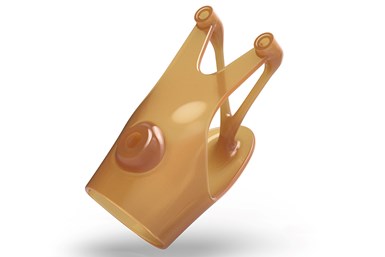3D Systems’ Accura AMX Resin Withstands Harsh Thermal Environments
Formnext 2023: The resin material is well suited for the testing of high-temperature components in applications such as HVAC, consumer appliances, motor enclosures, fixtures, mounts, stators, molding/tooling and more.
Share
Read Next
3D Systems’ Accura AMX High Temp 300C is an unfilled ultrahigh-temperature SLA resin that does not require a post thermal cure and is the engineered to meet the demands of applications requiring a HDT up to 300°C. Photo Credit: 3D Systems
3D Systems’ Accura AMX High-Temp 300C, is an ultrahigh-temperature stereolithography (SLA) resin that is engineered to meet the demands of applications requiring the highest levels of heat resistance. It is a print production-grade, highly thermal-resistant, translucent plastic for elevated temperature fluid or flow visualization.
The ultrahigh-temperature-resistant rigid plastic material is engineered to withstand the harshest thermal environments. The company says it is the industry’s most heat-resistant SLA material with a heat-deflection temperature (HDT) of over 300 °C at low stress (at 0.455 MPa) that does not require a post thermal cure.
This material is well suited for the testing of high-temperature components in applications such as HVAC, consumer appliances, motor enclosures, fixtures, mounts, stators, molding/tooling and many others.
Applications include high-temperature components testing and general-use parts, as well as low-pressure molding/tooling such as expanding foams and rubbers. It can also be used for functional prototype and production components for fixtures, mounts, housings, white goods and personal care products. It is also well suited for elevated-temperature fluid or gas flow visualization, and overmolding.
The resin also offers advantages such as a shortened production workflow and no requirement for a post thermal cure. It also provides excellent visualization for parts requiring evaluation of internal features and fluid flow performance; and chemical and auto fluid compatibility.
The resin also boasts isotropic properties. The SLA technology prints parts that are generally isotropic in mechanical properties, meaning the parts printed along either the XYZ axis will give similar results. Parts do not need to be oriented to get the highest mechanical properties, further improving the degree of freedom for part orientation for mechanical properties.
- Learn about 3D Systems verifying the performance of NASA’s GRX-810 Super Alloy. This oxide dispersion-strengthened alloy, developed by NASA, demonstrates exceptional mechanical properties and resistance to extreme temperatures, making it well suited for future use in critical components such as rocket engines, turbine blades and exhaust nozzle components.
- Read about 3D Systems developing materials and printer platform for improved digital dentistry. 3D Systems is strengthening its digital dentistry portfolio with new materials, NextDent Base and NextDent Cast, and a new printing platform, the NextDent LCD1.
Related Content
-
How to Improve Polymer AM Productivity 20X
A fast cycle time is critical to efficient production 3D printing, but it’s not the only thing. How you choose the right parts for AM, prepare jobs for production, and manage post processing will have just as big an impact on total 3D printing throughput. It all needs to work together to achieve maximum productivity.
-
Possibilities From Electroplating 3D Printed Plastic Parts
Adding layers of nickel or copper to 3D printed polymer can impart desired properties such as electrical conductivity, EMI shielding, abrasion resistance and improved strength — approaching and even exceeding 3D printed metal, according to RePliForm.
-
AM 101: Digital Light Synthesis (DLS)
Digital Light Synthesis (DLS) is the name for Carbon's resin-based 3D printing process. How it works and how it differs from stereolithography.
















